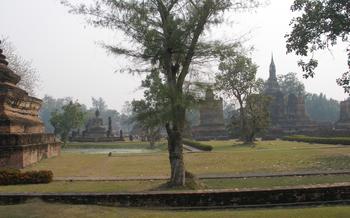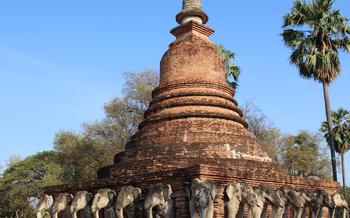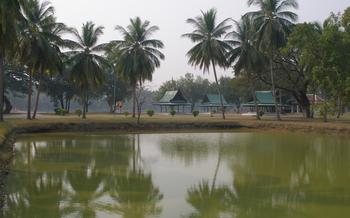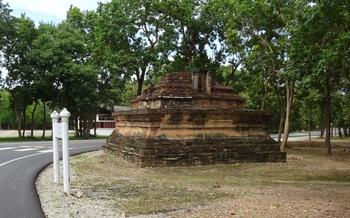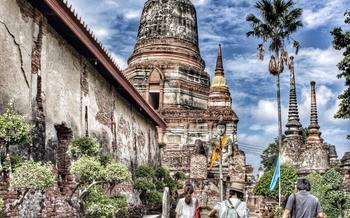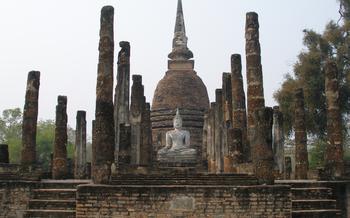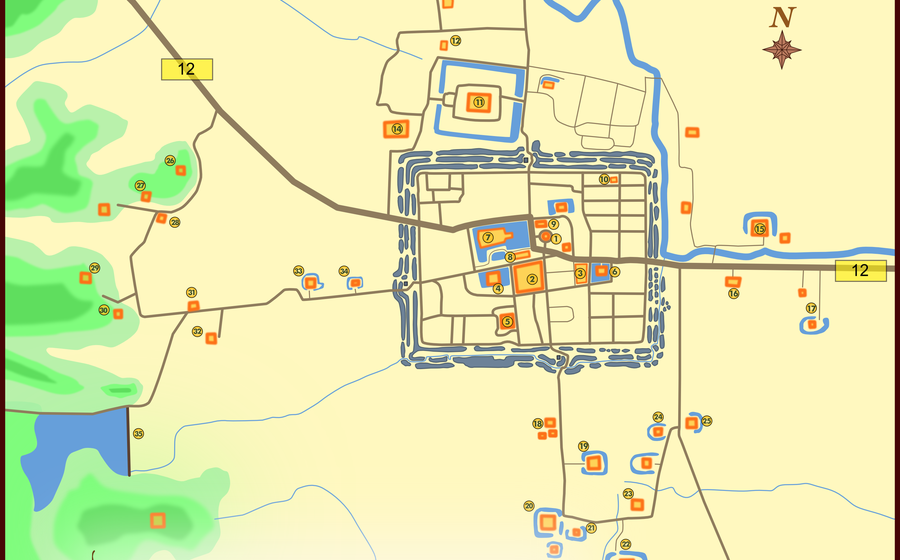
Wat Traphang Thong Lang
- Wat Traphang Thong Lang: A Historical Gem
- Exploring the Temple Grounds
- The Main Buddha Image
- The Ordination Hall
- The Stupas and Chedis
- The Surrounding Gardens
- Wat Traphang Thong Lang Museum
- Getting to Wat Traphang Thong Lang
- Hours of Operation and Admission Fees
- Local Festivals and Events
- Nearby Attractions
- Photography and Videography
- Ethical Tourism and Sustainability
- Wat Traphang Thong Lang in Literature and Arts
- Insider Tip: Hidden Gems
Wat Traphang Thong Lang: A Historical Gem
Wat Traphang Thong Lang stands as a testament to the rich history and cultural heritage of Thailand. Built in the 14th century during the Sukhothai Kingdom, this ancient temple holds a significant place in the religious and spiritual landscape of the country. Its unique architectural style, intricate carvings, and serene atmosphere make it a must-visit destination for anyone seeking to explore the wonders of Thailand's past.
The temple's name, which translates to "Temple of the Golden Pond," originates from the large pond that once surrounded the temple grounds. Today, visitors can still admire the remnants of this pond, which add to the temple's tranquil ambiance. Wat Traphang Thong Lang is not only a place of worship but also a repository of Thai art and culture. Its well-preserved murals, sculptures, and stupas offer a glimpse into the craftsmanship and artistry of the Sukhothai period.
As a sacred site, Wat Traphang Thong Lang holds deep religious significance for Thai Buddhists. Locals and pilgrims alike visit the temple to pay homage to the Buddha, offer prayers, and seek spiritual guidance. The temple's serene and contemplative atmosphere provides a sanctuary for those seeking inner peace and spiritual fulfillment.
Exploring the Temple Grounds
The sprawling temple grounds of Wat Traphang Thong Lang offer a journey into the past, with each corner revealing a hidden treasure. Entering through the main gate, visitors are greeted by a serene courtyard adorned with lush gardens, ancient trees, and intricate sculptures. The central pathway leads to the main chapel, flanked by a series of smaller shrines, stupas, and chedis.
Notable Buddha images and sculptures are scattered throughout the grounds, each with its own unique story to tell. Intricately carved stone Buddhas in various postures and mudras line the walkways, while smaller bronze and ceramic Buddha figures adorn niches and altars. Ancient stupas and chedis rise majestically, their bell-shaped spires reaching towards the heavens. These stupas, adorned with intricate carvings and colorful tiles, contain relics of Buddhist saints and revered monks.
Exploring the surrounding gardens offers a tranquil retreat from the bustling temple activity. Visitors can meander through paths lined with fragrant flowers, tropical plants, and towering trees. The gardens provide a peaceful oasis for meditation and contemplation, inviting visitors to connect with the temple's spiritual essence. The serene atmosphere, coupled with the gentle sound of wind rustling through the leaves, creates a sense of tranquility that is both uplifting and calming.
The Main Buddha Image
At the heart of Wat Traphang Thong Lang stands its most revered treasure – the majestic main Buddha image. Towering over the temple's interior, this colossal statue exudes an aura of serenity and divinity that captivates visitors. Carved from a single block of sandstone, the Buddha sits in a serene posture, embodying the essence of contemplation and enlightenment.
With its intricate details and exquisite craftsmanship, this image is a masterpiece of Sukhothai art. The Buddha's hands are gracefully positioned in the abhaya mudra, symbolizing protection and reassurance, while his serene expression radiates an aura of peace and compassion. The statue's intricate robe, adorned with delicate patterns, adds to its grandeur and elegance.
The history of this magnificent Buddha image is shrouded in mystery, adding to its allure. According to local legends, the statue was created by a renowned artisan who was guided by divine inspiration. It is believed that the artisan was so devoted to his work that he fasted and meditated throughout the creation process, imbuing the image with a sacred energy.
Devotees from near and far flock to Wat Traphang Thong Lang to pay homage to this revered Buddha image. They offer prayers, light candles, and place gold leaf on the statue as a symbol of their devotion and gratitude. The atmosphere within the temple is palpable, filled with a sense of reverence and spiritual connection.
The Ordination Hall
The ordination hall at Wat Traphang Thong Lang is a significant structure within the temple complex. Its architectural design showcases traditional Thai craftsmanship, featuring intricate carvings, pointed gables, and a tiered roof. The hall serves as a sacred space where Buddhist monks undergo the ordination ceremony, a rite of passage that marks their formal entry into the monastic order.
Inside the ordination hall, visitors can admire ancient murals and paintings that depict various Buddhist stories and teachings. These murals are not only visually stunning but also provide valuable insights into Thai Buddhist culture and history. The walls are adorned with scenes from the Buddha's life, as well as tales of his previous lives and his teachings. Each mural is meticulously crafted and tells a unique story, adding to the richness and depth of the temple's artistic heritage.
The ordination hall is still actively used for religious ceremonies and ordinations. Visitors are welcome to observe these ceremonies, but it is important to maintain a respectful demeanor and avoid disrupting the proceedings. The ordination ceremony is a solemn and sacred event, and being present during one is an opportunity to witness a glimpse of the deep spiritual traditions that are still practiced in Thailand.
The Stupas and Chedis
At Wat Traphang Thong Lang, visitors can marvel at a remarkable collection of stupas and chedis, each possessing unique symbolism and religious significance. These iconic structures, which are typically bell-shaped or spire-like in form, serve as monuments to the Buddha and his teachings, perpetuating his legacy for generations to come.
The temple grounds are adorned with stupas of varying sizes and designs, each representing a different aspect of Buddhist philosophy. Some stupas enshrine relics of the Buddha or his disciples, while others commemorate important events in his life. The chedis, on the other hand, are usually taller and more elaborate, often adorned with intricate carvings and stupas of their own, creating a visually stunning ensemble.
The most prominent stupa at Wat Traphang Thong Lang is the Phra That Traphang Thong, a towering structure that dominates the temple complex. This grand stupa is believed to contain relics of the Buddha, making it a sacred site for pilgrims and devotees. Its massive size and intricate design, featuring numerous tiers and decorative elements, symbolize the Buddha's profound wisdom and enlightenment.
Exploring the stupas and chedis at Wat Traphang Thong Lang is a journey through Buddhist history and symbolism. Each structure tells a story, offering insights into the beliefs and practices of the Thai people. Visitors can admire the craftsmanship and artistry that went into creating these monuments, appreciating their enduring significance in Thai culture and religion.
The Surrounding Gardens
The sprawling gardens that envelop Wat Traphang Thong Lang are an integral part of its charm and tranquility. Designed with meticulous care, the gardens feature a harmonious blend of manicured lawns, vibrant flower beds, and towering trees, creating a serene oasis amidst the ancient ruins.
Strolling through these verdant grounds, visitors can find respite from the bustling city and immerse themselves in nature's tranquility. The gardens offer a sanctuary for reflection and contemplation, inviting visitors to pause and appreciate the beauty that surrounds them.
The variety of plant life is astounding, with colorful bougainvillea, fragrant jasmine, and delicate orchids adding splashes of color to the landscape. Majestic trees, such as banyan and tamarind, provide shade and shelter, their branches reaching towards the sky like ancient guardians.
The gardens are not merely decorative; they hold deep symbolic and religious significance. According to Buddhist teachings, nature is sacred, and the creation of gardens within temple grounds represents the cultivation of inner peace and harmony. The gardens at Wat Traphang Thong Lang serve as a reminder of the interconnectedness between the natural world and the spiritual realm.
Whether seeking a moment of solitude amidst the serene beauty or simply admiring the exquisite craftsmanship of the gardens, visitors will find solace and inspiration within these verdant confines.
Wat Traphang Thong Lang Museum
Located within the temple complex, the Wat Traphang Thong Lang Museum offers visitors an in-depth look into the history, significance, and cultural heritage of the temple. The museum houses a collection of artifacts, relics, and ancient scriptures that shed light on the temple's construction, religious practices, and the lives of the monks who have resided here over the centuries.
Exhibits at the museum include detailed explanations of the temple's architectural style, the symbolism behind the Buddha images and stupas, and the various festivals and ceremonies that take place throughout the year. Visitors can also learn about the role of the temple in the local community and its impact on Thai culture and history.
The museum also offers educational programs and workshops, providing visitors with the opportunity to engage with the temple's history and teachings in a more interactive and immersive way. These programs are designed to foster a deeper understanding of Buddhism and Thai culture, and to promote cross-cultural exchange and dialogue.
Getting to Wat Traphang Thong Lang
Wat Traphang Thong Lang is situated in the Sukhothai Historical Park, approximately 12 kilometers from the city of Sukhothai. Visitors can conveniently reach the temple by various transportation options.
For those without their own transportation, guided tours are readily available from Sukhothai city. These tours typically include visits to other significant temples and historical sites within the park, providing a comprehensive exploration of Sukhothai's rich heritage.
Alternatively, visitors can opt for self-guided exploration by renting bicycles or motorbikes. The roads leading to the temple are well-maintained, making it a pleasant and scenic ride through the countryside.
Once at the temple, ample parking space is available for visitors' convenience, ensuring a hassle-free visit. The temple's accessibility and proximity to other attractions make it an ideal destination for history and culture enthusiasts seeking a deeper understanding of Thailand's past.
Hours of Operation and Admission Fees
Wat Traphang Thong Lang welcomes visitors throughout the week, inviting them to explore its sacred grounds and immerse themselves in its rich history. The temple is generally open from 8:00 AM to 5:00 PM, offering ample time for exploration and reflection.
Admission Fees: - Foreign visitors: 100 Thai Baht - Thai nationals: 20 Thai Baht
Discounts and Concessions: - Students and seniors with valid identification can enjoy a discounted admission fee of 50 Thai Baht.
Dress Code and Guidelines: - Visitors are kindly requested to dress respectfully when visiting the temple. This means avoiding shorts, tank tops, and revealing clothing. - Footwear should be removed before entering the main prayer hall and other sacred areas. - Visitors are encouraged to maintain a quiet and respectful demeanor while exploring the temple grounds.
Local Festivals and Events
Wat Traphang Thong Lang, like many other temples in Thailand, hosts several annual festivals and special events that draw both locals and tourists alike. These festivals celebrate important religious occasions, honor the temple's patron deities, and showcase the rich cultural traditions of the Sukhothai region.
One of the most significant festivals is the Phra Mongkhon Bophit Buddha Image Festival, held annually in February or March. During this festival, the temple's main Buddha image, Phra Mongkhon Bophit, is paraded through the streets of Sukhothai in a grand procession accompanied by music, dance, and colorful floats. Devotees offer prayers and make merit by pouring water over the Buddha image, seeking blessings for good luck and prosperity.
Another popular festival is the Songkran Festival, also known as the Thai New Year, which takes place in April. During Songkran, the temple grounds are transformed into a lively venue for water fights and other traditional activities. Locals and visitors alike splash water on each other as a symbol of cleansing and renewal, creating a joyous and festive atmosphere.
In addition to these major festivals, Wat Traphang Thong Lang also hosts various other events throughout the year, such as merit-making ceremonies, ordination ceremonies, and meditation retreats. These events provide opportunities for visitors to learn more about Thai Buddhist traditions, participate in religious rituals, and find inner peace and tranquility.
Nearby Attractions
Beyond Wat Traphang Thong Lang, the Sukhothai Historical Park is a treasure trove of ancient temples, ruins, and historical sites. Wat Mahathat, with its iconic central stupa and rows of Buddha images, is a must-see. Explore the atmospheric ruins of Wat Si Chum, where a giant Buddha image sits serenely amidst crumbling walls. Don't miss the impressive remains of Wat Phra Pai Luang, once the largest temple in Sukhothai.
For a taste of nature, head to Ramkhamhaeng National Park, just a short drive from the city. The park offers stunning landscapes, lush forests, and opportunities for hiking, camping, and wildlife spotting. Take a boat trip on the Yom River, which meanders through the park, offering serene views of the surrounding countryside.
Sukhothai city itself is a charming blend of history and modernity. Visit the lively night market for a taste of local delicacies and handicrafts. Explore the many local restaurants, cafes, and shops that line the streets of the old town. Sukhothai is also a great base for exploring other nearby attractions, such as the UNESCO World Heritage Site of Kamphaeng Phet Historical Park.
With its rich history, cultural heritage, and natural beauty, Sukhothai offers a wealth of experiences for every traveler. Whether you're interested in ancient temples, outdoor adventures, or simply soaking up the local atmosphere, Sukhothai is sure to leave a lasting impression.
Photography and Videography
Visitors are welcome to capture the beauty of Wat Traphang Thong Lang through photography and videography, but it's important to do so respectfully. Always remember that the temple is an active religious site, and worshippers should not be disturbed during ceremonies or meditation. Avoid using flash photography or loud noises that might disrupt the serene atmosphere.
When taking photos or videos, focus on capturing the architectural details, Buddha images, and the natural beauty of the gardens. Respect the privacy of other visitors and obtain their permission before taking their photos. Panoramic shots of the temple grounds can create stunning images, especially during sunrise or sunset.
To capture the essence of Wat Traphang Thong Lang, take your time to explore the temple complex and find hidden corners that offer unique perspectives. The intricate carvings on the ordination hall, the serene reflection of the Buddha image in the pond, and the lush greenery of the gardens all provide excellent photographic opportunities.
It's important to remember that Wat Traphang Thong Lang is a sacred place, and visitors should behave appropriately. Dress modestly, avoid loud conversations, and be mindful of your actions. By following these guidelines, you can contribute to preserving the sanctity of the temple while capturing its beauty for posterity.
Ethical Tourism and Sustainability
As responsible travelers, it is crucial to practice ethical tourism and sustainability when visiting Wat Traphang Thong Lang. Minimize your environmental impact by reducing plastic waste, respecting the temple's natural surroundings, and conserving water. Support local businesses by purchasing souvenirs from vendors near the temple and dining at local restaurants. Engage with the community respectfully, learn about their customs, and promote cultural understanding. By practicing ethical tourism, you can help preserve the temple's heritage while contributing to the well-being of the local community.
Wat Traphang Thong Lang in Literature and Arts
Wat Traphang Thong Lang's allure has permeated various forms of Thai arts and literature, becoming a symbol of Sukhothai's rich cultural heritage. In Thai literature, poets and writers have immortalized the temple's beauty and significance in their works, capturing its spiritual essence and historical importance. The temple's unique architectural features and serene atmosphere have also inspired artists, who have depicted it in paintings, sculptures, and even films. These artistic representations showcase the temple's grandeur and its role in shaping the cultural identity of Thailand. By exploring the temple through the lens of literature and arts, visitors can gain a deeper appreciation for its cultural significance and its enduring legacy in Thai society.
Insider Tip: Hidden Gems
Beyond the main attractions, Wat Traphang Thong Lang holds hidden gems waiting to be discovered. Explore the secluded corners of the temple complex, where you'll find intricate carvings, ancient inscriptions, and serene meditation spots. Look for the hidden Buddha images nestled among the trees or tucked away in forgotten corners. Discover the delicate murals adorning the walls of lesser-known shrines, depicting stories from Buddhist mythology. These hidden treasures offer a glimpse into the temple's rich history and spirituality, providing opportunities for quiet contemplation and a deeper connection with the site's sacred essence.
